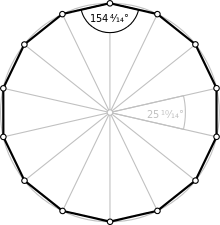Tetradecagon
| Regular tetradecagon | |
|---|---|
|
A regular tetradecagon | |
| Type | Regular polygon |
| Edges and vertices | 14 |
| Schläfli symbol |
{14} t{7} |
| Coxeter diagram |
|
| Symmetry group | Dihedral (D14), order 2×14 |
| Internal angle (degrees) | ≈154.2857° |
| Dual polygon | self |
| Properties | convex, cyclic, equilateral, isogonal, isotoxal |
In geometry, a tetradecagon (or tetrakaidecagon) is a polygon with 14 sides and angles.
A regular tetradecagon has Schläfli symbol {14} and can be constructed as a quasiregular truncated heptagon, t{7}, which alternates two types of edges.
Regular tetradecagon
The area of a regular tetradecagon of side length a is given by
Numismatic use
The regular tetradecagon is used as the shape of some commemorative gold and silver Malaysian coins, the number of sides representing the 14 states of the Malaysian Federation.[1]
Construction
A regular tetradecagon cannot be constructed using a compass and straightedge.[2] However, it is constructible using neusis, or with an angle trisector. The animation below gives an approximation of about 0.05° on the center angle:

Construction of an approximated regular tetradecagon
Related figures
A tetradecagram is a 14-sided star polygon, represented by symbol {14/n}. There are two regular star polygons: {14/3} and {14/5}, using the same vertices, but connecting every third or fifth points. There are also three compounds: {14/2} is reduced to 2{7} as two heptagons, while {14/4} and {14/6} are reduced to 2{7/2} and 2{7/3} as two different heptagrams, and finally {14/7} is reduced to seven digons.
| n | 1 | 2 | 3 | 4 | 5 | 6 | 7 |
|---|---|---|---|---|---|---|---|
| Form | Regular | Compound | Star polygon | Compound | Star polygon | Compound | |
| Image |  {14/1} = {14} |
.svg.png) {14/2} = 2{7} |
 {14/3} |
.svg.png) {14/4} = 2{7/2} |
 {14/5} |
.svg.png) {14/6} = 2{7/3} |
.svg.png) {14/7} or 7{2} |
| Internal angle | ≈154.286° | ≈128.571° | ≈102.857° | ≈77.1429° | ≈51.4286° | ≈25.7143° | 0° |
Deeper truncations of the regular heptagon and heptagrams can produce isogonal (vertex-transitive) intermediate tetradecagram forms with equally spaced vertices and two edge lengths. Other truncations can form double covering polyons 2{p/q}, namely: t{7/6}={14/6}=2{7/3}, t{7/4}={14/4}=2{7/2}, and t{7/2}={14/2}=2{7}.[3]
| Quasiregular | Isogonal | Quasiregular Double covering | ||
|---|---|---|---|---|
 t{7}={14} |
 |
 |
 |
 {7/6}={14/6} =2{7/3} |
 t{7/3}={14/3} |
 |
 |
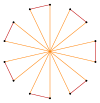 |
 t{7/4}={14/4} =2{7/2} |
 t{7/5}={14/5} |
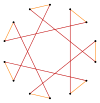 |
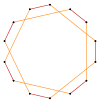 |
 |
 t{7/2}={14/2} =2{7} |
Petrie polygons
Regular skew tetradecagons exist as Petrie polygon for many higher-dimensional polytopes, shown in these skew orthogonal projections, including:
| B7 | 2I2(7) (4D) | |||
|---|---|---|---|---|
 7-orthoplex |
 7-cube |
 7-7 duopyramid |
 7-7 duoprism |
|
| A13 | D8 | E8 | ||
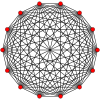 13-simplex |
 511 |
 151 |
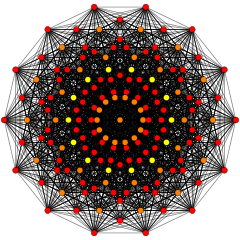 421 |
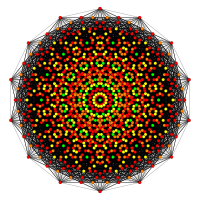 241 |
References
- ↑ The Numismatist, Volume 96, Issues 7-12, Page 1409, American Numismatic Association, 1983.
- ↑ Wantzel, Pierre (1837). "Recherches sur les moyens de Reconnaître si un Problème de géométrie peau se résoudre avec la règle et le compas". Journal de Mathématiques: 366–372.
- ↑ The Lighter Side of Mathematics: Proceedings of the Eugène Strens Memorial Conference on Recreational Mathematics and its History, (1994), Metamorphoses of polygons, Branko Grünbaum
External links
| ||||||||||||||||||||||||||
